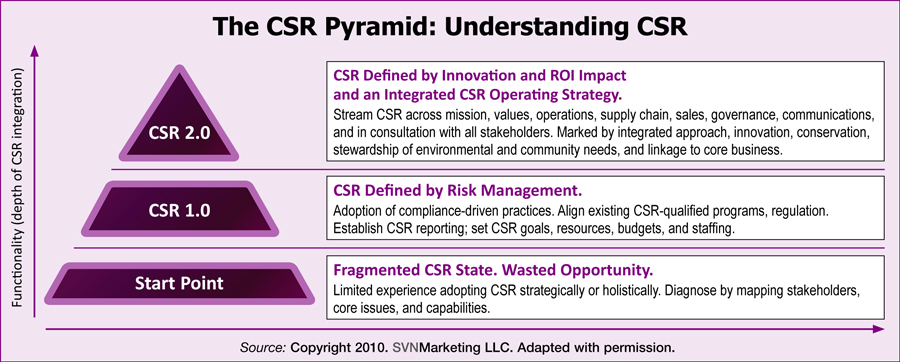Is your CSR program firmly in place in your organization? Have you established goals, set budgets and resources? Are you beginning to involve important stakeholders such as clients, customers and employees in your CSR efforts? If your answer is “yes” to these questions, you might be ready to take CSR to the next level.
There’s no question that corporate social responsibility and sustainability programs are a hot topic not only in PR, but in the business world in general. Furthermore, organizations are discovering that it’s OK to use “CSR” and “business” in the same sentence.
“CSR might have started out as philanthropy or pollution prevention, but it has gone through phases from ‘do less harm’ to ‘give something back’ to ‘addressing global challenges through business core competencies,’” says Dave Stangis, VP of CSR/sustainability at the Campbell Soup Company. “Businesses are now competing on CSR in terms of both market development and reputation.”
The key to using corporate social responsibility as a competitive weapon is to move your CSR and sustainability efforts from level 1.0 to 2.0, says Susan Nickbarg, principal at CSR and marketing consultancy SVN Marketing (see graphic on page 6). “Move past CSR 1.0’s risk, conservation and reputation management practices and reboot into CSR 2.0, where your efforts move the ROI needle through innovation,” she says. “The trick is in managing the brand, or business, equally with an integrated CSR lens.”
On the heels of the Feb. 24 PR News CSR Awards event, where it was more than apparent that such innovation is taking place, we spoke to top practitioners about strategic and tactical steps they’ve taken to move up to CSR 2.0.
EMBED CSR
Perhaps overused as a marketing term, integration nonetheless is critical as CSR efforts grow and mature. Stangis has proved to be a master in achieving such integration, growing Intel into a CSR power (No. 1 in the Dow Jones Sustainability Index for seven straight years), and now engineering Campbell’s rise.
Tying CSR into the business units is a must, says Stangis, who, after arriving at Campbell’s in September 2008, organized a management committee comprised of corporate officers, divided into four functional teams: environment, workplace, customer/consumer and community.
To further weave CSR into the business, Campbell’s now has a variable compensation plan that adds CSR and sustainability into individual performance objectives. The plan is built around some 15 different metrics. In addition, several CSR metrics are included in executives’ balanced scorecards. “We’re trying to build accountability, and every executive is affected,” says Stangis.
PRODUCT INNOVATION
Not only does integration include internal accountability efforts, but embedding CSR values in offerings are key in reaching the 2.0 plateau.
One company that emphasizes product innovation within CSR is telecom company BT. Within its product development process, CSR “checkpoints” are introduced, says Kevin Moss, head of CSR for BT Americas. “So instead of just making sure the thing is going to work, our product people add sustainability into the mix,” says Moss.
As an example, Moss cites a wireless BT product that is placed in soda vending machines and tells warehouse workers how much soda, if any, is needed for delivery. “The product has reduced drivers’ number of visits by 10% and reduces the truckload by as much as 30%,” he says.

FIND WAYS TO MEASURE
In light of that BT product, the ability to measure CSR efforts is critical. Setting measurable goals is a work in progress at Campbell Soup Company, says Stangis. He believes setting long-term goals is important. In the case of Campbell’s, its 10-year “destination targets” cover a number of CSR areas, including water and energy.
Another metric under exploration is the ability to measure child hunger and obesity over time through Campbell’s wellness programs. “Social measurement is something that you’re going to hear a lot more of across organizations,” says Stangis.
TIE TO SALES
Still, at the end of the day, it’s the ROI that’s most important. As Stangis puts it, the question is, “Am I going to sell more soup?” In this regard, companies are successfully leveraging CSR efforts with sales.
In the case of BT, the integration of CSR with its sales unit has paid off in terms of attracting new—and keeping current—BT customers, says Mike McGuire, VP and general manager of operations at BT’s Business Solutions Group. Simply by making the sales force aware of CSR, and having them talk about it with clients and prospects, has fostered long-term business. BT, says McGuire, makes it a point to consider a potential customer’s own CSR efforts when deciding on a relationship. “By sharing the same values, both organizations are able to get through any rough patches,” he says.
FORWARD THINKING
BT’s Moss has a simple suggestion of where organizations should be in terms of CSR: “There are companies that make money and follow the laws. There are companies that do good things in the community,” he says. “Now organizations are edging toward the middle through social entrepreneurship—intersecting profit objectives with CSR values and goals.” PRN
CONTACT:
Dave Stangis, [email protected]; Susan Nickbarg, [email protected]; Kevin Moss, csrperspective.com; Mike McGuire, [email protected].
